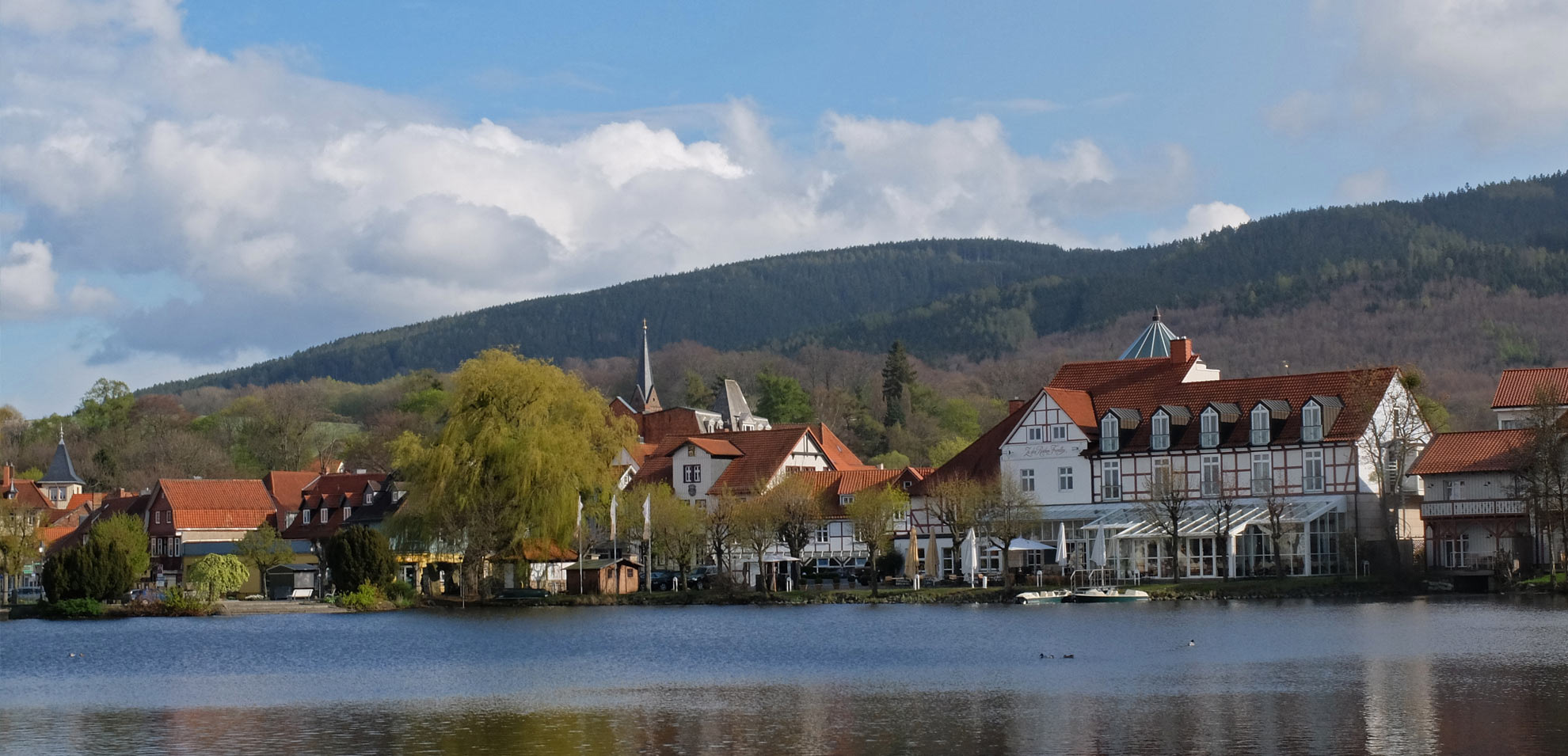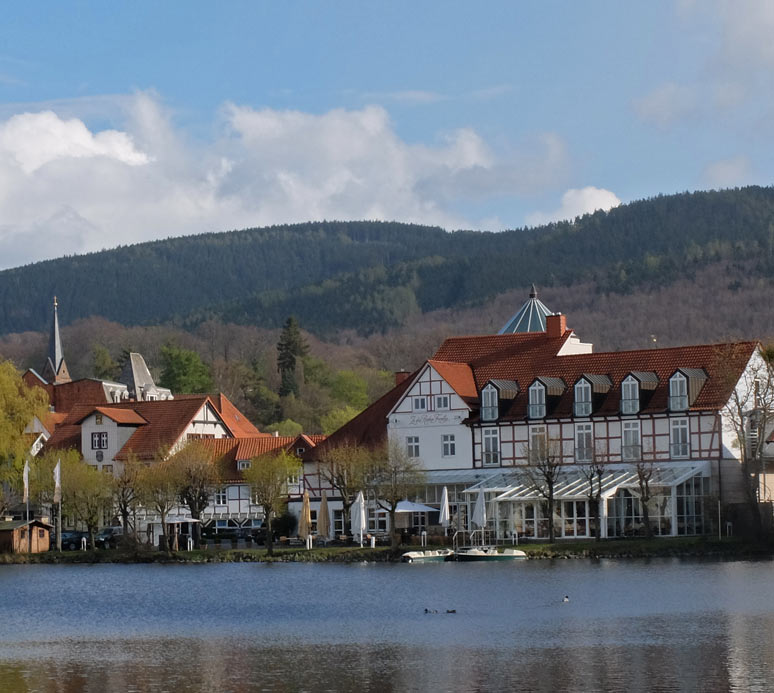

GASTRONOMY WITH LONG EXPERIENCE: OUR HISTORY
Already a few hundred years ago, today’s country house “Zu den Rothen Forellen” in Ilsenburg was a popular rest stop and hostel for travelers in the Harz Mountains, who climbed the Brocken from here.
The list of famous names also obliges us to continue this tradition of hospitality to live up to the fame of the house. The writer Heinrich Heine stayed in this house, as did Friedrich Schiller with his wife. The Scandinavian fairy-tale poet Hans Christian Andersen stopped off in idyllic Ilsenburg on his long journeys, as did Tsar Peter and the German Kaiser Wilhelm.
And still today we may welcome in our house celebrities from politics, economy and art, who follow the reputation of the country house “Zu den Rothen Forellen” and its excellent gastronomy, which reaches far beyond the borders of the Harz.
Epilogue: Over 400 years of history …
To bring our history into a summary is hardly possible without giving up details, anecdotes and stories. If the walls of the hotel could tell the story, there would be material for more than just one novel.
For us, the long history means a gastronomic tradition to which we are committed, committed with an eye to the future, without losing sight of the past. You, dear guests, will continue to write the history of the house and we will be happy to be your hosts in the process.
16./17. Century: From the “Campe’schen Hof” to the “Stöltenkrug
16th century – Campe’s court
The origin of the country house “Zu den Rothen Forellen” goes back to the late 16th century, when, along with the economic boom caused by the metallurgical industry, the “Campe’sche Hof”, a so-called Junkerhof, was also built in 1574. This was inhabited by Hilmar von Campe, who, as a member of a Saxon noble family, was appointed administrator of the pledged Ilsenburg monastery and its estates at the end of the 16th century. Until 1611, the farm was still in the hands of the von Campe family, after that the owners changed, but due to the nobility of the farm, all of them must have been of noble birth.
17th century – The “Stöltenkrug
The Steltenkrug, Steltzenkrug or Stöltenkrug, whose history is also closely linked to that of the “Rothe Forelle”, was built at the end of the 16th century, more precisely in 1572, when the count’s ironworks were in full bloom and more businessmen and visitors were coming to Ilsenburg. It served as accommodation for the count’s cottage officials, who did not want to settle for the only existing and rustic-looking “Gemeindekrug”. The Stöltenkrug established, so to speak, the gastronomic tradition of the later country house “Zu den Rothen Forellen”. It is assumed that the Stöltenkrug was privately owned before it passed into count’s rule. Under count’s rule it was given in lease, first in temporary, later in hereditary lease. From 1634 onwards, there is a list of tenants, although it is not complete. In 1770 the form of lease was changed from time lease to hereditary lease in order to reduce the frequent change of lease.
Since the smelter officials and smelters were obliged to drink or buy their beer only in the Stöltenkrug, the management of the time flourished. The number of applicants for the lease was always very high, with 6 to 8 applicants, and due to the large profit that came with the good sales, they often outbid the lease to be able to farm this “gold mine”. The jug itself experienced not only “golden times”. In 1747, guests complained about “adulterated beer” and the later “Schwarze Hirsch” also proved to be the most miserable village tavern.
18./19. Century: From the “Black Stag” to the “Red Trout
18th century – Black stag
Only in the In the 18th century, a noble owner is again known by name; it was the General von Meinecke, whose sarcophagus can still be found on the northern wall of St. Mary’s Church. After the brief renaming of the pub to “Schwarzer Hirsch” (Black Deer) under the tenant Freytag, who ran it on a hereditary lease, at the beginning of the At the beginning of the 19th century, the count’s administration considered abandoning this inn. The slow blossoming of tourism brought with it the need for a larger, more respectable inn. The widow of Meinecke then sold the Junkerhof to the counts of Stolberg-Wernigerode in 1803. With the property of the deceased general, the count’s administration owned an appropriate estate, which seemed to be made for a larger inn due to its size and the possibility for extensions and garden facilities. Therefore, the tenants Freytag were approached and negotiated for the repurchase of the leasehold, which took place on 30.08.1803.
19th century – inn “Rothe Trout
After some reconstruction work on Meineck’s property, the new inn opened here on 01.09.1803, which at the same time also took over the count’s “Schenkgerechtigkeit”. The furnishing of the new inn was taken over by the count’s pension, which estimated the costs at about 1000 riksdalers. In the beginning, mainly employees of the steelworks frequented the “Herrschaftliche Schänke”. The newly built inn continued the tradition of the old Stelten-, Steltzen- or also Stöltenkrug. On 31.03.1804 the inn was renamed to “Rothe Forelle” (red trout). The name refers to the count’s coat of arms, which shows red trout on a white background. Until 1856, the estate was administratively managed, during which time the inn flourished. Constant guests continued to be the hut officials, in addition to merchants who had business relations with the hut and, of course, the increasing Harz hikers who found “pleasant accommodation” here.
The inn had many amenities, including a gondola on the upper lodge and current trout pond, a bowling alley, and mules and donkeys for guests to climb the Brocken. The increasing tourism made a new extension necessary in 1845, which was to include a hall, 4 additional guest rooms and a dormitory in the outbuilding (cost: 3,000 thalers).
20th century: Traditional restaurant in an eventful century
After renewed and alternate leasing of the inn, it was sold in 1890 to Fritz Lichtenberg, who extended it with a branch and a bathhouse. A further reconstruction, necessary for the operation, then took place in 1920. Despite difficult economic times in the 1920s, the inn remained in the possession of the Lichtenberg family. Due to a temporary misuse of the hotel as mass quarters for members of foreign forced laborers in the 1940s, the hotel then came completely down. In 1942, the last owner, Dr. Otto Lichtenberg, sold the entire property to the Ilsenburg municipality. Since there was lively interest in putting the hotel back into operation, various structural changes were made for this purpose at considerable expense in order to create a “first-class” hotel.
After the end of World War II, the hotel was confiscated and used first by the Americans, then by the English, and from July 1945 by the Russian army as a local commandant’s office. The then hotel owner and Nazi activist Sedlacek (purchase 1944) was taken into custody and died in prison. In July 1946, the Russian army once again handed over the hotel “Zu den Rothen Forellen” to the town of Ilsenburg.
In 1948, the hotel was finally transferred to the Ilsenburg municipality, which was again looking for a tenant for the property. This was found with Mr. A. Höpner, to whom it was to be owed at all that under the time conditions the “Rothe Forelle” could be taken again gastronomically in enterprise. Even during the time of the workers’ and peasants’ state, the “Rothe Forelle” remained a hotel business. However, the structural condition deteriorated and renovations were carried out only cautiously. The hotel operation then ended again in October 1993.
Present: Our charm is passion. Everything! Except ordinary …
In the course of the reconstruction, the historic buildings were gutted, the “dance hall” was enlarged by the addition of the winter garden and furnished as a restaurant. The half-timbering was restored and rebricked, and all electrical wiring and plumbing was reinstalled. In the newly built annex, additional rooms, a modern seminar area and, last but not least, a bathing and sauna area were created. After only 14 months of construction, the carefully renovated current country house “Zu den Rothen Forellen” opened in July 1995 and quickly became known far beyond the borders of the region. Soon the hotel was classified – as the first hotel in Saxony-Anhalt, the country house “Zu den Rothen Forellen” was awarded 5 stars in 1996. Since April 2010 the country house “Zu den Rothen Forellen” belongs to the small, fine group of private hotels Dr. Lohbeck:
“The average gives the world its existence –
the extraordinary its value” (Oskar Wilde).
This philosophy is lived in all houses of the private hotels Dr. Lohbeck: with joy, with cordiality and with passion. Every employee knows that they are allowed to work for their guest in an extraordinary place.
Every day, every single employee sets themselves the task: “I want to make my guest a regular!” Personality and personal closeness are therefore so important to us, which is why all hotels are family-owned and family-run.
As the owning family, the Dr. Lohbeck family stands with its name behind the performance of its houses. Privathotel Dr. Lohbeck includes only selected and “hand-picked” hotels of the four- and five-star category. Cultivated hotel comfort welcomes the guest and dignified and qualified service unobtrusively accompany him during his stay. Enjoy us!
CONTACT
Privathotels Dr. Lohbeck GmbH & Co.KG
ambassador hotel & spa
In the bath 26
25826 St. Peter-Ording
Phone: +49 (0) 4863 / 7090
Fax: +49 (0) 4863 / 2666
E-mail: info@hotel-ambassador.de
PRIVATE HOTELS DR. LOHBECK
SOCIAL MEDIA

